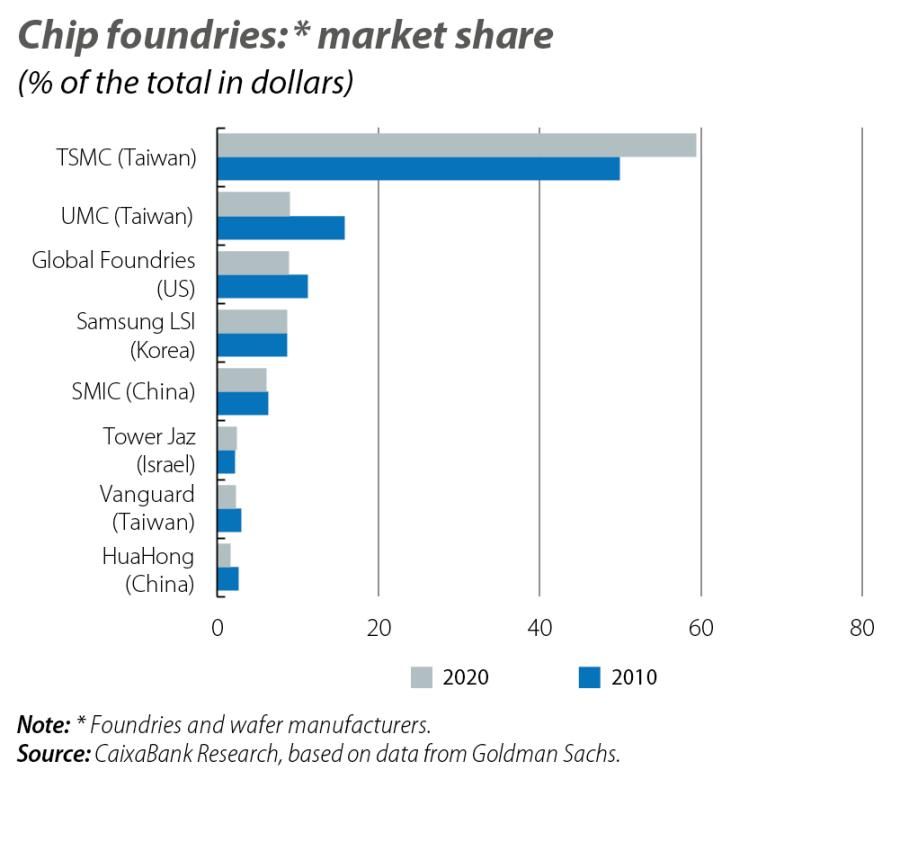The chip shortage is going nowhere fast
What’s behind the semiconductor shortage? Is it a transitory phenomenon attributable to the pandemic or does it also reflect structural factors linked to the specific characteristics of the sector?

The shortage of semiconductors (or chips) and the associated bottlenecks constitute one of the most significant features of the post-pandemic economy. This shortage has affected many manufacturing sectors, and the car industry in particular, which in Europe plays a major role in the economy. It has also contributed to bottlenecks that are generating inflationary pressure and could hold back economic activity. But what lies behind this phenomenon? Are these chip bottlenecks a transient phenomenon attributable to the pandemic, or do they also reflect structural factors resulting from the sector’s specific characteristics?
Macroeconomic factors
The post-pandemic economy is characterised by significant unmet demand, especially in private consumption, which is receiving an additional boost from the pent-up savings amassed during the lockdown. Also, the demand in this reopening phase is proving particularly high in the case of information and communication technology goods, driven by the rise in teleworking and remote learning (computers, tablets, etc.), and these goods require large quantities of chips. Moreover, a considerable portion of this demand has been directed towards the purchase of cars, which also need semiconductors. While some of this excess demand ought to correct itself over the coming quarters as consumption patterns normalise and pent-up savings fade, there are other more structural forces which could cause the chip shortage to persist.
Firstly, there is the technological decoupling between China and the US, which is set to continue in the coming years and is disrupting chip supply chains. Secondly, the transition towards electric cars will also increase the demand for semiconductors, as they use more chips than internal combustion vehicles. Thirdly, and perhaps most importantly, there is the idiosyncratic structure of the semiconductor industry.
What makes the semiconductor industry special?
Semiconductor firms can be divided into three groups. There are Integrated Device Manufacturers (IDMs, such as Intel, Samsung or Texas Instruments), which handle both the design and the manufacturing; so-called fabless firms, which only design their chips and outsource the production (such as Nvidia, Qualcom or AMD), and pure play foundries (such as Taiwan Semiconductor), which only manufacture other companies’ designs.
In this semiconductor value chain, the foundries are the critical point. This is firstly because the high fixed cost of manufacturing chips, especially the most advanced ones (less than 28 nm)1, makes it very financially costly to have manufacturing units sitting idle (see first chart). Moreover, this high cost means that vast investments are required, posing a formidable barrier to entry. Thirdly, the complexity of wafer manufacturing requires a high degree of specialisation and also requires the customer – in this case the designer – to provide the manufacturer with a great deal of sensitive information if they want the product to meet their specifications. As a result, the economies of scale in the industry and the flows of sensitive information between customers and manufacturers tend to encourage concentration.
- 1The complexity of chips is measured by how small they are, and the unit of measurement is a nanometre (nm), representing a billionth of a metre. The fewer nanometres a chip measures, the more advanced or sophisticated it is. The most advanced ones currently measure 3 nm, but those under 28 nm are already considered relatively advanced.

A concentrated market
A prime example of the key role of foundries in the sector is the fact that, over the past 20 years, the foundry market has grown at an annual rate of 10% (74 billion dollars in 2020), whilst the total semiconductor market has grown by 4% (239 billion dollars in 2020). The investment bank Goldman Sachs expects the demand for advanced nodes (under 28 nm) to cause the foundry market to grow at a rate of 15% per annum through to 2023, before returning to 10% in 2024-2025. In comparison to the previous cycle, the foundry industry is now more concentrated. Taiwan Semiconductor is the biggest pure play foundry. In 2020 it accounted for 59% of the total wafer market, compared to 50% in 2010, and in the case of highly advanced chips (less than 10 nm, a 21.1-billion-dollar market) the concentration is even higher (Taiwan Semiconductor produces around 90% of the total) (see second chart). Trailing far behind, the second biggest wafer manufacturer is Samsung. On the other hand, the aforementioned technological decoupling of the US and China has severely affected the Chinese firm SMIC (Semiconductor Manufacturing International Company), since the recent US restrictions prevent it from using certain American technology.

Europe, where are you going?
In this environment of structural chip shortages, the big tech giants, such as Faang (an acronym for the leading US technology companies),2 are using their greater bargaining power to meet their high demand ahead of other industries, such as the automotive industry.
Europe is seeking to bolster its own semiconductor industry and to explore the possibility of developing European chip manufacturing. The problem is that the starting point is a long way behind the technological cutting edge, especially in the manufacture of wafers. This, coupled with the aforementioned investment requirements, means that significant long-term effort involving the major European economies is required. The European dilemma is whether to seek short-term solutions to alleviate the situation in the automotive sector or to compete directly with Taiwan. Without drastic policy changes, this looks like a chimera.
- 2Namely, Facebook, Amazon, Apple, Netflix and Alphabet.